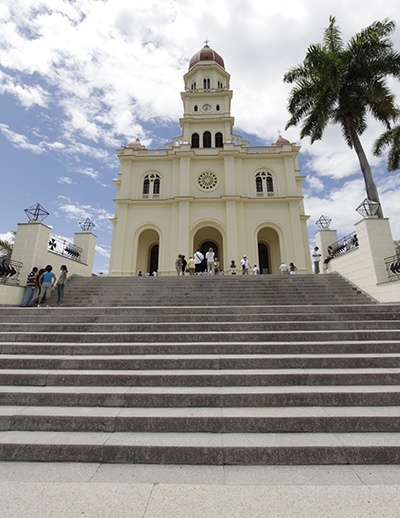
Patroness of Cuba
Monday, September 1, 2014
*Rogelio Zelada

Photographer: ANA RODRIGUEZ-SOTO | FC
View of the 256 steps leading up to the Shrine of Our Lady of Charity in El Cobre. Most pilgrims do not enter through the front though, but through the back on the right side, where they can leave letters of thanksgiving and symbolic mementos when their prayers are answered.
This story is preserved, along with other tales, at the Sanctuary Basilica of El Cobre in the province of Santiago, Cuba. It is said that the one who left made a pilgrimage to the sanctuary to ask for Our Lady of Charity’s intercession and his father’s forgiveness, while his father asked for the same, and that both met while individually climbing the steps leading to the niche that houses the image of the patroness of Cubans.
Since the image was found at the beginning of the 17th century in the waters of the Bay of Nipe, Our Lady of Charity of El Cobre became the heart of a people that embraced her as a merciful mother. It was a presence that bequeathed a Cuban identity to a people who were beginning a historical journey fraught with great difficulties and setbacks; a journey she accompanied at every moment: both when Cuba belonged to Spain and when it stopped belonging.
From her modest shrine in the Villa de Santiago del Prado in eastern Cuba, where copper mines were located, she welcomed pilgrims of all races and social status, and heard prayers, lamentations and grateful deeds day by day, minute by minute. She did not hesitate to take to the hills with the liberating army of her people as they endured pain and sacrifice to taste the gift of liberty and justice for the first time.
For that reason, it made perfect sense that when the Church granted Cuba the novelty of a native episcopate, it would be Archbishop Francisco de Paula Barnada y Aguilar, the first archbishop of Santiago, who would ask Pope Pius X to declare Our Lady of Charity patroness of the young nation, on Oct. 25, 1905 – only three years after the Republic of Cuba was proclaimed. The petition was presented again Aug. 29, 1906 with the help of Archbishop Giuseppe Aversa, Apostolic Delegate of the Holy See.
ANNUAL CELEBRATION
 The community is invited to join the Cuban faithful in honoring their patroness, Our Lady of Charity, on her feast day, Sept. 8, beginning at 5 p.m. at the Bank United Center on the campus of the University of Miami. The image will arrive at 6 p.m., rosary will begin at 6:30 p.m. and the Mass, presided by Archbishop Thomas Wenski, will begin at 8 p.m.
The community is invited to join the Cuban faithful in honoring their patroness, Our Lady of Charity, on her feast day, Sept. 8, beginning at 5 p.m. at the Bank United Center on the campus of the University of Miami. The image will arrive at 6 p.m., rosary will begin at 6:30 p.m. and the Mass, presided by Archbishop Thomas Wenski, will begin at 8 p.m.

On Jan. 21, 1907, the Sacred Congregation of Rites replied, asking that, based on the norms promulgated by Pope Urban VIII, the request of the bishop of Santiago should be “supplemented by the clergy and people, with letters of support from the country’s bishops, from the archdioceses as well as the suffragan sees.”
At the time, the Cuban Church was beginning to rise from the ashes of a long war of independence, and in the midst of a newly formed republic pierced by a very strong anti-clericalism. It was a poor church in a very poor country, devoid of priests, education, social works and catechesis, where everything remained to be done.
As Archbishop of Santiago de Cuba, Archbishop Barnada was custodian of the image of Our Lady of Charity and her shrine, which had been partly destroyed by the collapse of a portion of a copper mine. He was a great devotee of the “virgen morena” (dark-skinned virgin), whose blessed image he ordered to be placed on his episcopal coat of arms; and he was a true patriot whose signature headed a declaration from the island’s 53 priests, sent to Leo XIII in 1898, expressing the longing for liberty of the people and clergy of Cuba, and their right to fight for it.
Even though Archbishop Barnada did not succeed in convincing Pope Pius X to declare Our Lady of Charity patroness of Cuba, his effort paved the way. On Sept. 24, 1915, the veterans of the Mambí Army asked Benedict XV to officially proclaim what had always been a fact among her children: Our Lady of Charity as the heavenly patroness of Cuba. This time, the pope responded positively. He signed the document May 10, 1916, when a Salesian, Archbishop Félix Ambrosio Guerra, was archbishop of Santiago.
In 2015 and 2016, the Cuban people will celebrate the two great centennials of this historic fact. What the Church began and was finally accomplished by the Mambises should make us all feel full of gratitude and healthy pride, as we have a history which cannot be written without the profound and intimate presence of the Blessed Virgin, Our Lady of Charity of El Cobre, our patroness.
A significant portion of the information provided here comes from the extraordinary research done by Dr. Guillermo Fernández Toledo, “Los precursores del patronazgo de la Virgen de la Caridad” (The pioneers of the patronage of Our Lady of Charity), published in Verdad y Esperanza magazine (Unión Católica de Prensa de Cuba), Second Season, Year 3, No. 3, 2011, pages 30-33.
At the time, the Cuban Church was beginning to rise from the ashes of a long war of independence, and in the midst of a newly formed republic pierced by a very strong anti-clericalism. It was a poor church in a very poor country, devoid of priests, education, social works and catechesis, where everything remained to be done.
As Archbishop of Santiago de Cuba, Archbishop Barnada was custodian of the image of Our Lady of Charity and her shrine, which had been partly destroyed by the collapse of a portion of a copper mine. He was a great devotee of the “virgen morena” (dark-skinned virgin), whose blessed image he ordered to be placed on his episcopal coat of arms; and he was a true patriot whose signature headed a declaration from the island’s 53 priests, sent to Leo XIII in 1898, expressing the longing for liberty of the people and clergy of Cuba, and their right to fight for it.
Even though Archbishop Barnada did not succeed in convincing Pope Pius X to declare Our Lady of Charity patroness of Cuba, his effort paved the way. On Sept. 24, 1915, the veterans of the Mambí Army asked Benedict XV to officially proclaim what had always been a fact among her children: Our Lady of Charity as the heavenly patroness of Cuba. This time, the pope responded positively. He signed the document May 10, 1916, when a Salesian, Archbishop Félix Ambrosio Guerra, was archbishop of Santiago.
In 2015 and 2016, the Cuban people will celebrate the two great centennials of this historic fact. What the Church began and was finally accomplished by the Mambises should make us all feel full of gratitude and healthy pride, as we have a history which cannot be written without the profound and intimate presence of the Blessed Virgin, Our Lady of Charity of El Cobre, our patroness.
A significant portion of the information provided here comes from the extraordinary research done by Dr. Guillermo Fernández Toledo, “Los precursores del patronazgo de la Virgen de la Caridad” (The pioneers of the patronage of Our Lady of Charity), published in Verdad y Esperanza magazine (Unión Católica de Prensa de Cuba), Second Season, Year 3, No. 3, 2011, pages 30-33.


Comments from readers